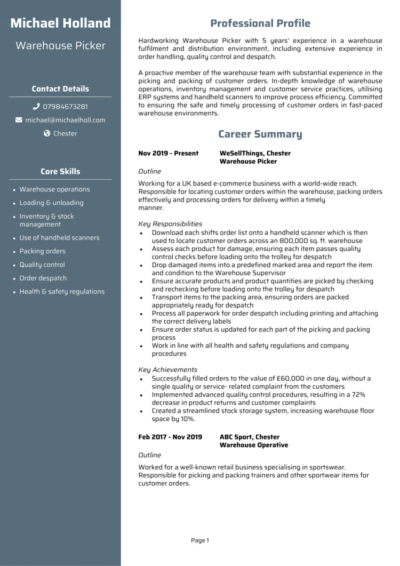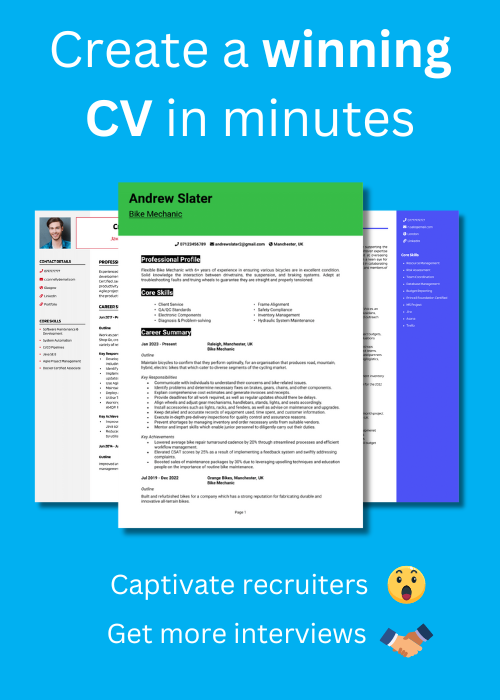Fast hands, sharp eyes, and a knack for keeping things moving – your role keeps the wheels of distribution turning. But when it’s time to move your career forward, the packing gets tricky: how do you bundle all that experience into a tidy, effective CV?
This guide will help you do just that. With a Picker Packer CV example and clear, practical advice, you’ll learn how to highlight your reliability and efficiency – and help you get hired faster.
Picker Packer CV example
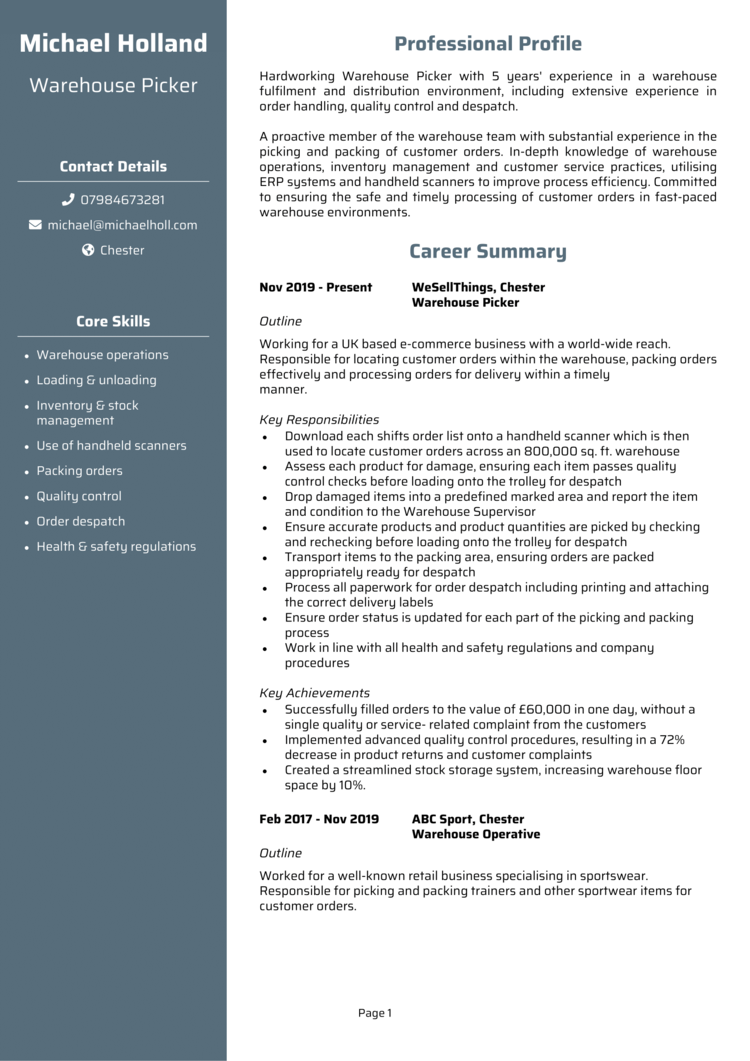
How to write your Picker Packer CV
Discover how to craft a winning Picker Packer CV that lands interviews with this simple step-by-step guide.
Picker packers are trusted to follow instructions precisely and handle goods with care – all while keeping up with demanding schedules. Your CV should reflect the same qualities, showing that you’re focused on what really matters.
This guide covers everything you need to know, from writing a CV to how to phrase your experience and highlight your value to employers in warehousing, retail, and logistics.
How to structure and format your Picker Packer CV
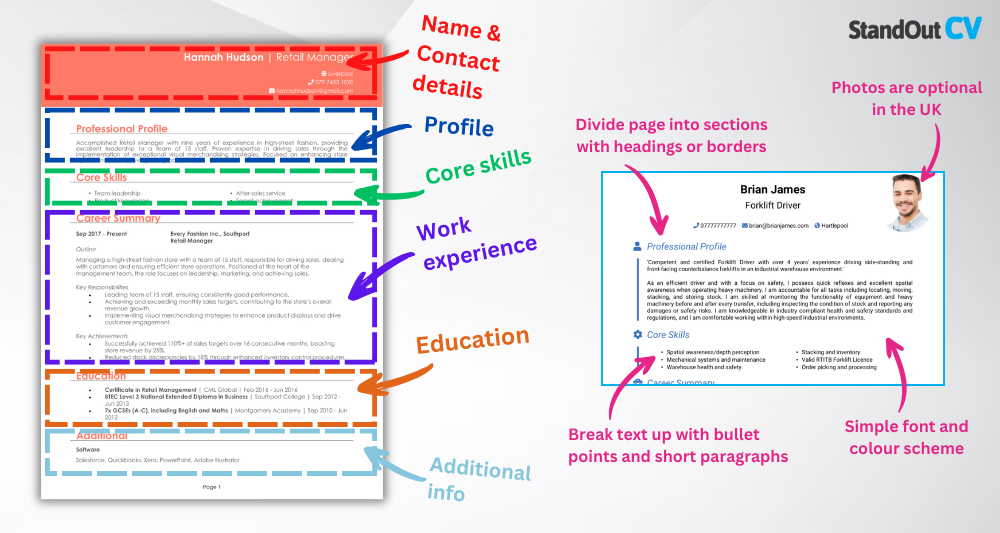
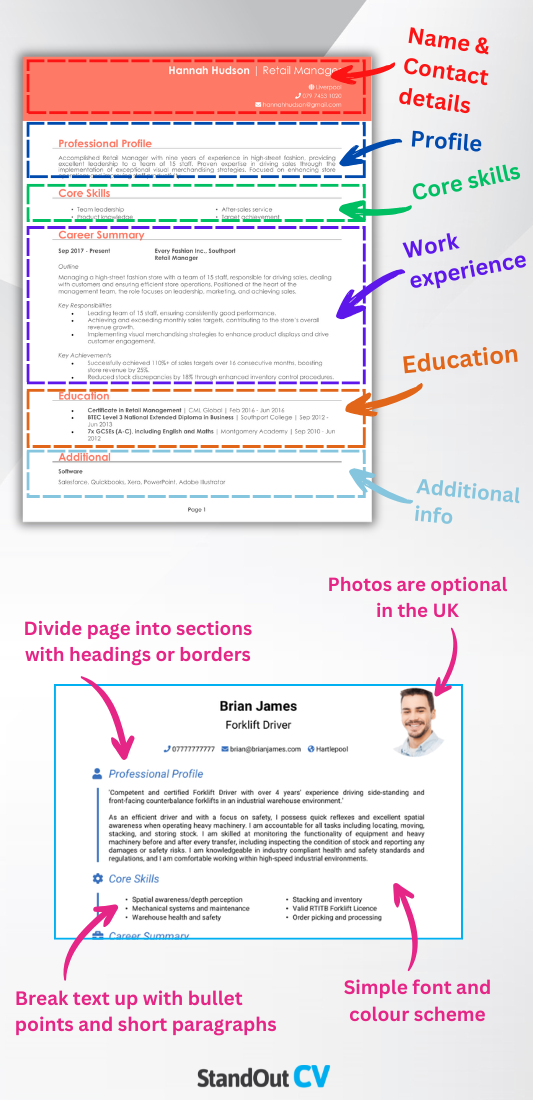
A great picker packer CV doesn’t need bells and whistles – but it does need to be clean and quick to read. Think of it like a well-labelled parcel: everything in the right place, with no room for confusion. Your structure should make reading your CV as straightforward as possible, so recruiters don’t just move onto the next applicant.
Here’s the layout to follow:
- Name and contact details – Keep your name and personal details front and centre at the top. Whether or not to include a photo is your decision.
- Profile – Start with a snapshot of your skills, career highlights, and professional aspirations.
- Core skills – Focus on core skills, making it easy for employers to see your key strengths at a glance.
- Work experience – Walk through your professional experience, beginning with your latest position and moving backwards.
- Education – Outline your education and certifications, focusing on those most relevant to the role.
- Additional info – This section is optional, but it’s a good place for hobbies and interests that complement your CV.
Use bullet points to break up the information and help recruiters find what they’re looking for at a glance. Choose a font that’s easy to read, and use clear section headings throughout. Make good use of white space to avoid a cramped look, and always keep your CV length under two pages. A tidy format which follows these tips show you understand efficiency – before they’ve even read a word.
How to write a Picker Packer CV profile


Your CV profile sits at the top of your CV and gives the recruiter a snapshot of who you are and what you bring to the table. Even for hands-on roles like this, a short paragraph makes a big difference – it helps set the tone and gives your application a personal touch.
Use it to show that you’re reliable and capable of working in fast-paced environments – while also giving a hint at your attitude and work ethic.
Picker Packer CV profile examples
Profile 1
Reliable Picker Packer with over five years of experience in high-volume warehouse environments. Skilled in handling goods, operating scanning equipment, and maintaining accurate stock records. Known for meeting tight deadlines while maintaining attention to detail and adhering to health and safety protocols.
Profile 2
Hardworking Picker Packer with three years of experience in e-commerce fulfilment centres. Efficient in order processing, inventory handling, and packing products to exact specifications. Committed to maintaining speed and accuracy during busy seasonal periods.
Profile 3
Motivated Picker Packer with experience working in food distribution and logistics. Familiar with chilled and ambient storage procedures, palletising goods, and using handheld scanners. Focused on quality control, cleanliness, and working collaboratively as part of a team.
Details to put in your Picker Packer CV profile
Include the following:
- Where you worked – Briefly state the types of warehouses, distribution centres, or retail environments you’ve worked in.
- Your top qualifications – Mention any training or certifications you’ve completed related to logistics, safety, or warehouse operations.
- Essential skills – Highlight your ability to follow procedures, maintain quality, and hit performance targets.
- Tools or equipment used – Mention any experience operating tools, systems, or warehouse machinery.
- Value delivered – Emphasise how your work helped maintain speed, reduce errors, or keep supply chains running smoothly.
What to include in the core skills section of your CV


This section gives employers a fast summary of what you’re good at – it’s one of the quickest ways for them to check if you match what they’re looking for. Focus on hard, measurable CV skills that are directly relevant to the role, and make sure they align with the requirements in the job advert.
Just a few well-chosen points can show that you’re the right person for the job, so keep them relevant and easy to scan.
What are the most important skills for a Picker Packer CV?
- Order Picking Accuracy – Selecting the correct items from inventory based on order slips or digital picking systems.
- Packing and Labelling – Packaging items securely and accurately labelling parcels for shipment to ensure they reach the correct destination.
- Stock Organisation and Retrieval – Keeping inventory areas tidy and systematically arranged to streamline the picking process.
- Use of Scanners and Warehouse Systems – Operating barcode scanners and warehouse management software to track orders and stock movement.
- Quality Control Checks – Inspecting items for damage or errors before packing to maintain quality standards.
- Manual Handling and Lifting – Safely lifting, moving, and stacking goods in line with health and safety guidelines.
- Dispatch Preparation – Sorting packed orders by delivery method or courier and preparing them for collection or dispatch.
- Inventory Monitoring – Reporting low stock levels and assisting with restocking to ensure availability of items.
- Workstation Cleanliness and Organisation – Maintaining a clean, safe, and efficient work area to meet hygiene and safety standards.
- Team Collaboration and Workflow Support – Working with other warehouse staff to meet order deadlines and maintain productivity.
How to write a strong work experience section for your CV


Your work experience section should reflect your ability to work hard, follow procedures, and deliver consistently. Even if your past roles were similar, it’s worth showing how you added value in each one – especially if you’ve worked in different environments, used different systems, or picked different kinds of products.
List your roles in reverse chronological order. For each job, start with a short summary of the company and your role. Then use bullet points to describe what you did, how you did it, and your achievements – especially if you worked to targets and improved accuracy during operations.
The best way to structure job entries on your CV

- Outline – Introduce the company and explain your role in basic terms. Mention what kind of products you handled, who you reported to, or the size of the operation.
- Responsibilities – Use action words like “packed” and “monitored.” For example: “packed fragile items following strict handling guidelines” or “monitored stock levels and reported discrepancies.”
- Achievements – Show the impact you made. Did you improve accuracy, exceed daily targets, or help train new staff? Use numbers where you can to show results.
Sample jobs for Picker Packer
Picker Packer | Brampton Fulfilment Solutions
Outline
Worked in a fast-paced warehouse environment fulfilling orders for an online retail client.
Responsibilities
- Picked products from shelves using handheld scanning devices
- Checked items against order sheets and reported discrepancies
- Packed products securely for delivery, following packaging guidelines
- Labelled packages and moved completed orders to dispatch area
- Maintained cleanliness of picking stations and followed safety procedures
Achievements
- Maintained 99.7% order accuracy over six months
- Exceeded daily pick targets by 15% during peak periods
- Recognised for consistent punctuality and teamwork
Picker Packer | Greystone Food Logistics
Outline
Handled picking and packing of chilled and frozen food products for supermarket distribution.
Responsibilities
- Followed batch picking lists to collect products from multiple zones
- Used voice-picking technology to locate items and confirm quantities
- Inspected products for damage and best-before dates
- Built pallets for outbound deliveries and shrink-wrapped for transit
- Adhered to cold chain procedures and hygiene standards
Achievements
- Helped reduce product waste by identifying stock rotation issues
- Improved pick accuracy through training and attention to detail
- Supported new starters with system use and area familiarisation
Picker Packer | NovoSupply Hub
Outline
Carried out general warehouse duties and order fulfilment tasks for an electronics supplier.
Responsibilities
- Retrieved items from storage zones based on digital order tickets
- Checked and packaged fragile items using protective materials
- Processed orders through warehouse management system
- Assisted in weekly stocktakes and inventory reporting
- Worked with dispatch team to meet courier deadlines
Achievements
- Reduced packaging errors by 40% after suggesting clearer labelling
- Improved order turnaround speed during flash sale events
- Maintained perfect attendance record over 12-month period
How to list your educational history


You don’t need a degree to land a picker packer role, but your education section still matters. Include your most recent or relevant qualifications, whether that’s GCSEs, a college course, or any health and safety training. If you’ve completed warehouse-specific training or certifications, mention those too.
This section should be short and to the point – just a few bullet points showing that you meet the basic requirements and have invested in your own development.
What are the best qualifications for a Picker Packer CV?
- Level 1 or 2 Certificate in Warehousing and Storage – A practical qualification that covers packing, picking, and health and safety
- Manual Handling Certificate – Often required for warehouse and logistics work
- Health and Safety in the Workplace (Level 1 or 2) – Demonstrates awareness of workplace safety rules and responsibilities
- First Aid at Work – Useful in larger or high-risk warehouse environments
- GCSEs or Functional Skills (Maths and English) – Often required for communication and basic record-keeping


